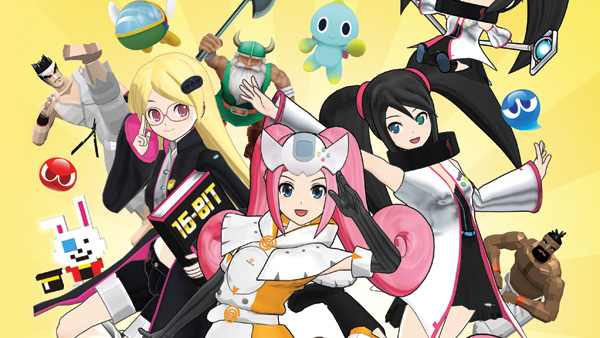
We’re busy anime fans here at Otaku USA, and that means we
need our anime delivered in quick, bite-sized chunks. Luckily, in recent years the anime industry has obliged our tight schedules—as well as our rapidly diminishing attention spans—with a whole cottage industry of anime shorts of all shapes and sizes. In fact, short anime has now become the medium of choice for many experimental artists attempting exciting new things with animated comedy. From lightning-fast tennis clubs to chiseled stone idols to ludicrous superhero parodies, it would seem that short anime is the new … well, anime.
Here we celebrate some of our favorite anime series with episodes shorter than the normal TV length of 24 minutes!
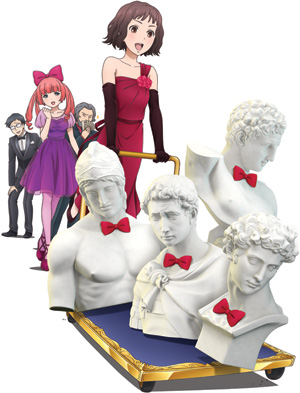 Sekko Boys
Sekko Boys
Miki Ishimoto had her fill of sculptures during her run at art school, so imagine her surprise when she starts a new career in idol management only to find … more sculptures. Even though art school helped cultivate her willpower and stamina, she took the time to contemplate the nature of art. Her conclusion was thus: Since show business moves people and their hearts, THAT is what’s truly art to her. Her conviction is strong, but it’s not enough to prepare her for a career managing the brand-new idol group, consisting of leader St. Gorgio, Holy Soldier; Mars, Soldier Devoted to Love; Hermes, the Fine-skinned Renaissance Man; and Medici, “The Original Rich and Famous.” Together they are… the Sekko Boys, four talking gypsum busts who instigate the situational comedy of their ridiculous series of anime shorts.
Sekko Boys is an original series directed by Tomoki Takuno (Yamada-kun and the Seven Witches), with Michiko Yokote (Genshiken, Squid Girl, Cute High Earth Defense Club LOVE!) handling series composition. The brief and amusing LIDEN FILMS production is the perfect example of a show that could only really succeed in a short format. The gags hit harder, the characters get fleshed out just enough, and the end theme will consistently have you shouting, “S-E-K-K-O! B-O-Y-S! SEKKO!”
– Joseph Luster

Wooser’s Hand-to-Mouth Life
There’s nothing cuter than Wooser’s Hand-to-Mouth Life, hands down. One of the most adorable shorts out there on the Internet, it follows Wooser, a strange rabbit-like animal who loves girls, money, eating, and … memes?
The series spans several three-to-four minute episodes with some of the cutest animation you’ve seen, but don’t let the look of things fool you. Wooser himself may be adorable, but he’s perverted, weird, and gluttonous. He hangs out with a host of cute girls and a “nega” version of himself called Darth Wooser as well as a raccoon and a birdlike creature. If it sounds weird, that’s because it totally is, but that’s a good thing.
The episodes themselves make very little sense, with surreal “plots,” non-sequiturs, and random vignettes that serve little purpose other than showing off just how weird this series of shorts can be. But trying to make sense of it just won’t work. To enjoy Wooser, you have to stop trying to understand Wooser. Once you do that, all will become clear. And then you’ll become one of us. One of us! One of us!
– Brittany Vincent
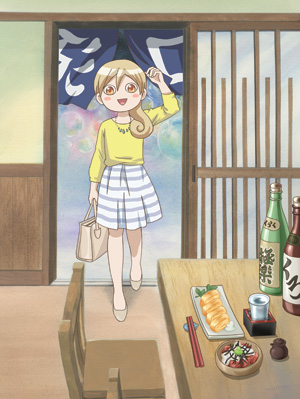 Wakako-zake
Wakako-zake
Faithfully adapting Chie Shinkyu’s manga of the same name, Wakako-zake portrays 26-year-old office worker Murasaki Wakako as she enjoys eating and drinking alone at various izakayas. Yup, that’s it, and it’s downright mesmerizing. As opposed to food porn wherein the dishes themselves or the effort with which they’re made is the focus, Wakako-zake largely entrances the audience by training its attention on Wakako’s thoughts as she eats. Miyuki Sawashiro as Wakako is amazing in her delivery of inner-monologue meditations on taste, texture, and varying degrees of delight (hereafter referred to as utterances of “Pshuuu”). So convincing are these depictions of food and drink calming Wakako that the same effect transfers to the viewer. Sadly, this 12-episode adaptation (available on Crunchyroll.com) represents but a minute fraction of the content in the original manga and only lightly, albeit slyly, hints at/touches on the rationale—stress from office or social drama—behind Wakako’s escapism. Her loner attitude, visually reflected via her unique, slightly disturbing, oddly cute, perfectly spherical head, is one of my favorite aspects of the premise. Still, the concise storyboarding and editing, evident in how much information each three-minute episode manages to convey, are astounding and beckon multiple helpings.
– Ink
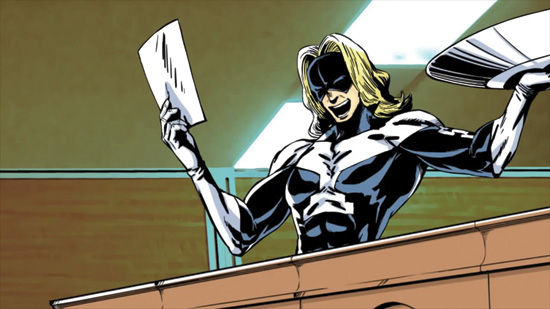
Inferno Cop
Before Kiznaiver, before Kill la Kill, and before Little Witch Academia, Studio Trigger released something very different: Inferno Cop, a series of absurd three-minute comedy shorts produced on a shoestring budget. Our hero is a cop from hell whose face is a flaming skull with sunglasses and who is definitely not just a ripoff of Ghost Rider. On his quest to get revenge on the evil organization Southern Cross for killing his family (as well as their other heinous crimes, which include shoplifting), he does battle with a host of bizarre enemies, including a masked super villain named MISTER JUDGE, a trio of crooked FBI agents who are incapable of saying anything other than “FBI,” and even “Real God.” If all this sounds a little stupid, it’s because it is, and Inferno Cop revels in its own stream-of-consciousness lunacy. The story meetings for each episode reportedly consisted of 45 minutes of playing with Marvel action figures and 15 minutes of hasty writing, which explains why the story jumps with gleeful abandon from one idea to the next, taking Inferno Cop through a zombie apocalypse,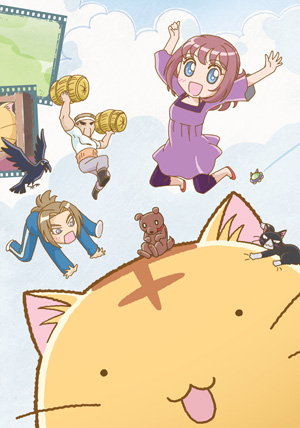 an Egyptian pyramid, and even the prehistoric past. Unfortunately, a lot of fans get scared off by the show’s lo-fi visual style, which consists of cutout illustrations and photo backgrounds. It’s essentially Anime Aqua Teen Hunger Force, and like that series, the comedy largely hinges on impeccable comedic timing and clever meta-jokes about its own low-budget production. With Inferno Cop lookalike Chief Overjustice running an entire space police force over in Space Patrol Luluco, it seems like a perfect time for anime fans to rediscover the hero we all deserve.
an Egyptian pyramid, and even the prehistoric past. Unfortunately, a lot of fans get scared off by the show’s lo-fi visual style, which consists of cutout illustrations and photo backgrounds. It’s essentially Anime Aqua Teen Hunger Force, and like that series, the comedy largely hinges on impeccable comedic timing and clever meta-jokes about its own low-budget production. With Inferno Cop lookalike Chief Overjustice running an entire space police force over in Space Patrol Luluco, it seems like a perfect time for anime fans to rediscover the hero we all deserve.
– Evan Minto
Poyopoyo
In this five-minute, largely nonlinear episodic anime based on Ru Tatuki’s 4-koma Poyopoyo Kansatsu Nikki, a spherical orange cat is adopted into the Sato household; cuteness and hilarity ensue. I’m not a cat person at all (dogs rule!), but the wonders and woes of pet ownership are universal. With writing that realistically reflects how owners would react to situations that come about largely due to Poyo’s abnormal shape, the series manages to strike a variety of tones, from tender to goofy, quite naturally. That Poyo only mews with an overwhelmingly adorable “Hyaaaa” and doesn’t talk like other anime cats (I’m lookin’ at you, Chi!) furthers a realism that fosters an acceptance of the absurd to make jokes, such as mistaking a cake that has just been cut for the cat, perhaps a little funnier than they should be. The bright color palette and cute character designs, along with the warmth and energy in the voice actors’ performances, make this an absolute delight to watch episode after episode. The concept doesn’t wear thin, even after 52 episodes, and each is infinitely rewatchable (on Crunchyroll) whenever you need a dose of awwww.
– Ink
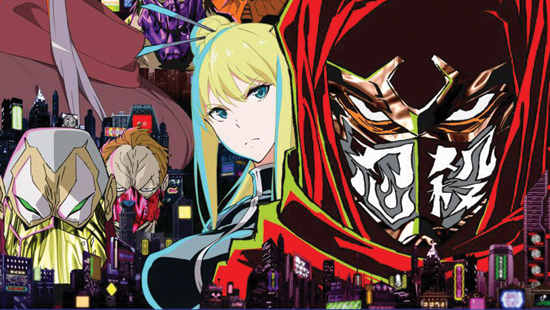
Ninja Slayer From Animation
Studio Trigger has a reputation for oddball, conceptual comedy, but it’s never made anything quite as difficult to explain as Ninja Slayer. The series of 15-minute shorts is based on a Japanese novel series compiled from tweets purporting to be translations of self-published American novels about ninja, written by reclusive (and totally not made-up) authors Bradley Bond and Phillip “Ninj@“ Morzez. The plot, which revolves around a vengeful “ninja who kills ninja” (in case you didn’t pick up on that already) is little more than a flimsy excuse for pulpy ninja antics inspired by martial arts films and comic books—ninja politely introduce themselves before fighting and recite “death haikus” before exploding with Aqua Teen-style stock explosion effects. Though the original source material isn’t created by Trigger, the studio basically took the series as an opportunity to create a spiritual successor to Inferno Cop. It’s at its best when being patently absurd, utilizing Inferno Cop’s cutout style and an amped-up 1990s neon color scheme for visual gags that subvert audience expectations for slick action anime. However, the mix of more serious dramatic content undercuts that silliness, making for entire episodes that go by with barely any jokes. It’s not the strongest entry in Trigger’s catalog, but considering that Inferno Cop 2 is nowhere to be found as of this writing, Ninja Cop is the best we’re going to get.
– Evan Minto
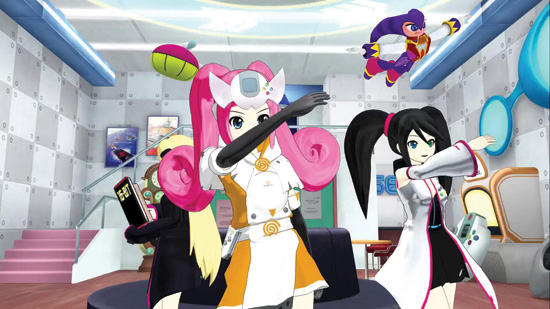
Hi-sCool! Seha Girls
Imagine Sega consoles if they happened to be a group of absolutely adorable moe girls. Now stop imagining and check out Hi-sCool! Seha Girls, because that’s exactly what this series of shorts is. Three cuties repping the Sega Mega Drive, Saturn, and Dreamcast go to Sega High School while participating in Sega-related activities in order to graduate.
It’s a veritable playground for gamers of all walks of life who enjoy Sega’s cadre of releases and systems, with references to games like Fantasy Zone, Jet Set Radio, and even Puyo Puyo. It’s like giving a trio of Sega fangirls the means to create a short series about whatever they want and letting them run free with CG and super bright, bubbly animation.
Don’t expect anything terribly nuanced or creative, but get ready for some of the cutest video game-related animation crossed with moe girls in the entire anime landscape.
– Brittany Vincent

